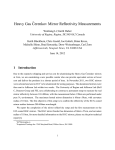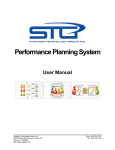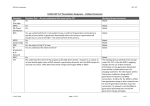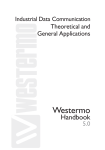Download User Manual for the EDCM charging model (Jan 2013)
Transcript
Manual for the EDCM2 model (Combined demand and generation) input data (15 January 2013) Model version r5247 (FCP) and r5248 (LRIC) Overview .............................................................................................................................. 1 Input data sheets and tables .............................................................................................. 3 911. FCP power flow modelling data ............................................................................... 3 913. LRIC power flow modelling data .............................................................................. 4 935. Tariff input data ....................................................................................................... 5 1100. Company name, charging year and version ....................................................... 13 1105. Diversity allowance between level exit and GSP Group (from CDCM table 2611) 13 1113. General inputs ..................................................................................................... 13 1122. Forecast system simultaneous maximum load (kW) from CDCM users (from CDCM table 2506) ........................................................................................................ 15 1131. Assets in CDCM model (from CDCM table 2705) ................................................ 15 1132. Override notional asset rate for 132kV/HV (£/kW) ............................................... 15 1133. Maximum network use factor ............................................................................... 15 1134. Minimum network use factor ............................................................................... 16 1135. Loss adjustment factor to transmission for each network level (from CDCM table 2004) ............................................................................................................................. 16 1181. LDNO discounts .................................................................................................. 16 1182. CDCM end user tariffs ......................................................................................... 17 1183. LDNO volume data .............................................................................................. 17 4601. Horizontal information......................................................................................... 17 Overview 1. This is a user manual for the input data tables of the combined model implementing the EHV distribution charging methodology (EDCM) for import tariffs and export tariffs connected to electricity distribution networks in Great Britain. 2. This version is consistent with the model versions r5247 (FCP) and r5248 (LRIC). Sheets 3. Sheets in the workbook have been given short abbreviated names. This is to make the best use of screen space given the way in which Microsoft Excel displays information. Tables 4. Each sheet is structured as a list of data tables, to be read from top to bottom — like a book. 5. Each data table has a three- or four-digit table number. Numbers that start with 9 or 11 are assigned for input data tables, are their numbers do not change from version Page 1 to version of the model. Other table numbers are assigned tables that carry out intermediate calculations or present the resulting tariffs. Hyperlinks in the workbook 6. The Forward and Back buttons on Microsoft Excel’s Web toolbar can be useful when navigating around the workbook using these hyperlinks. For example, to go back to where you were before clicking a hyperlink, use the Back button. 7. To show the Web toolbar in Microsoft Excel 2000–2004, select Web from Toolbars from the View menu (details may vary depending on the Excel version). The Web toolbar has been removed from Microsoft Excel 2007, but the Back and Forward buttons can be added to the Quick Access Toolbar instead. 8. Links do not work well if the model is displayed within a web browser. To get the full functionality, save the model as a file and open it in Microsoft Excel or compatible software. Technologies and dependencies 9. The model is implemented as a stand-alone Microsoft Excel workbook in Excel 2007 file format. No software other than Microsoft Excel 2007 or above, or compatible software, is needed to operate the model. 10. The model relies on standard spreadsheet formulae. It does not use any macros, Visual Basic for Application, pivot tables, solver, goal seek, or array formulae. 11. The workbook is produced by a computer programme in the programming language Perl 5. This programme can be run on a personal computer or as a web service, and can generate versions of the models with different tariffs or allocation rules. Overview sheet 12. The overview sheet (Overview) lists the data tables in the workbook. Input sheets 13. In the EDCM model, there are two types of input data tables: (a) Some input tables are long database-style tables. These have a number between 900 and 999 and are on a worksheet of their own to facilitate copypaste operations. (b) Some input tables are like CDCM input data tables. They are given a number between 1100 and 1199 and appear on sheet 11. 14. The input data sheets have numerical names: (a) Sheet ―11‖ contains all the input data tables with a number starting 11. (b) Sheet ―911‖ (FCP models only) contains table 911 only (FCP location data). (c) Sheet ―913‖ (LRIC models only) contains table 913 only (LRIC location data). (d) Sheet ―935‖ contains table 935 only (volume data and tariff mappings). Page 2 Input data sheets and tables 15. This section reviews each of the input data sheets, providing guidance on data definitions and possible data sources wherever possible. 911. FCP power flow modelling data 16. Sheet 911 is only included in FCP models. Table 911, the only table in the sheet, contains outputs from the FCP power flow modelling and reinforcement costing analysis. 17. A description of each column in table 911 is provided below. Location name/ID 18. This is a unique identifier for the location (any combination of letters and numbers is permissible, provided that it is unique in Microsoft Excel’s view). The location might be either a network group or a pseudo-hybrid network group in the case of a network group with two or more parent or grandparent groups. 19. It is important to ensure that that this identifier is unique. Level 20. Data in this column are not used. Parent location (if any) 21. This column contains the location name/ID of the higher level network group serving the location. This is to be left blank if the location is at the top of the hierarchy. Charge 1 £/kVA/year 22. This is the network group charge in £/kVA/year for demand (load). Under the FCP methodology, this number is always zero or positive. If this number is positive, it will be a charge to demand users connected to that network group, and a credit to nonintermittent generation users connected to that network group. Not used (Previously ―Charge 2 £/kVA/year‖) 23. Data in this column are not used. Maximum demand run: load kW 24. This is the total relevant active power consumption in kW in the maximum demand scenario. 25. This number is always zero or negative. Maximum demand run: load kVAr 26. This is the total relevant reactive power consumption in kVAr in the maximum demand scenario. 27. This number is negative if the current calculated for demand lags its voltage. Page 3 Maximum demand run: generation kW 28. This is the total relevant active power generation in kW in the maximum demand scenario. 29. This number is zero or always positive. Maximum demand run: generation kVAr 30. This is the total relevant reactive power generation in kVAr in the maximum demand scenario. 31. This number is positive if the current calculated for demand lags its voltage. Not used (Previously ―Minimum demand run: load kW‖) 32. Data in this column are not used. Not used (Previously ―Minimum demand run: load kVAr‖) 33. Data in this column are not used. Not used (Previously ―Minimum demand run: generation kW‖) 34. Data in this column are not used. Not used (Previously ―Minimum demand run: generation kVAr‖) 35. Data in this column are not used. 913. LRIC power flow modelling data 36. Sheet 913 is only included in LRIC models. Table 913, the only table in the sheet, contains outputs from the LRIC power flow modelling and reinforcement costing analysis. 37. A description of each column in table 913 is provided below. Location name/ID 38. A unique identifier for the location (any combination of letters and numbers is permissible, provided that it is unique in Microsoft Excel’s view). 39. It is important to ensure that that this identifier is unique. Demand or Generation 40. This should contain the word ―Demand‖ or ―Generation‖, indicating how the load at the relevant location was modelled. Linked location (if any) 41. This should be blank unless this location is one of several feeders serving the same EDCM customer. Page 4 42. If an EDCM customer is served by several locations (feeders) then a chain-linked list of these locations must be established through the linked location field. 43. The chain-linked list should be uni-directional, and not circular. For example, take a chain-linked list with three linked locations, A, B and C. One of these locations should be selected as the first link in the chain. If the first location is A, then one of either Location B or location C (let’s say B) should be entered as the linked location for location A. The third location (in this case, C) should be as the linked location for location B. Location C should not have a linked location entered against it. Local charge 1 £/kVA/year 44. This is the local £/kVA/year charge at the location under maximum demand conditions. 45. This number may be positive or negative. If this is positive, it is a charge to demand at that location or a credit to non-intermittent generation at that location. Remote charge 1 £/kVA/year 46. This is the remote £/kVA/year charge at the location under maximum demand conditions. 47. This number may be positive or negative. If this is positive, it is a charge to demand at that location or a credit to non-intermittent generation at that location. Not used 48. Data in this column are not used. Not used 49. Data in this column are not used. Maximum demand run: kW 50. This is the total relevant active power in kW in the maximum demand scenario. This number is positive for a generation flows and negative for demand flows. Maximum demand run: kVAr 51. This is the total relevant reactive power in kVAr in the maximum demand scenario. This number has the same sign as kW in the maximum demand run if the current calculated for demand lags its voltage. Not used (Previously ―Minimum demand run: kW‖) 52. Data in this column are not used. Not used (Previously ―Minimum demand run: kVAr‖) 53. Data in this column are not used. 935. Tariff input data 54. This table provides input information about each EDCM tariff. Page 5 55. There needs to be one line in table 935 for each of the following: (a) A tariff, and this can be an import-only tariff, an export-only tariff or a import and export tariff. Tariffs where all three of the import capacity, exempt export capacity and non-exempt export capacity are either zero, blank, or VOID are not permitted in table 935, unless these are part of completely blank rows. (b) A portfolio tariff element for any tariff on any LDNO network, nested network or offshore network which is subject to a site-specific locational element of a portfolio tariff. 56. A description of each column in table 935 is provided below. Name 57. This is a full name/identifier for the tariff. This is for labelling purposes and does not affect any calculations. Maximum import capacity (kVA) 58. This column should contain the forecast average maximum import capacity over the charging year. If you do not want to calculate a any import charges for a particular tariff, or include in the calculation of import charges for other customers data relating to a particular tariff, please enter the text string ―VOID‖ in this column. Any other entry (including blank or zero) will result in import charges being calculated and displayed for this tariff. Exempt export capacity (kVA) 59. This column should contain the export capacity (in kVA) of the customer associated with the tariff that is exempt from use of system charges. Non-exempt pre-2005 export capacity (kVA) 60. This column should contain the export capacity (in kVA) the customer associated with the tariff that: (a) is subject to use of system charges; and (b) had connected before 1 April 2005. 61. If you do not want to calculate a full set of export charges for a particular tariff (for example, a demand-only tariff), please enter the text string ―VOID‖ in this column. Any other entry (including blank or zero) will result in export charges being calculated and displayed for this tariff. Non-exempt 2005-2010 export capacity (kVA) 62. This column should contain the export capacity (in kVA) the customer associated with the tariff that: (a) is subject to use of system charges; and (b) had connected on or after 1 April 2005, but before 1 April 2010. Page 6 63. If you do not want to calculate a full set of export charges for a particular tariff (for example, a demand-only tariff), please enter the text string ―VOID‖ in this column. Any other entry (including blank or zero) will result in export charges being calculated and displayed for this tariff. Non-exempt post-2010 export capacity (kVA) 64. This column should contain the export capacity (in kVA) the customer associated with the tariff that: (a) is subject to use of system charges; and (b) had connected on or after 1 April 2010. 65. This column should include any capacity that is forecast to connect during the charging year. 66. If you do not want to calculate a full set of export charges for a particular tariff (for example, a demand-only tariff), please enter the text string ―VOID‖ in this column. Any other entry (including blank or zero) will result in export charges being calculated and displayed for this tariff. Sole use asset MEAV (£) 67. This is the modern equivalent asset value of the sole use assets attributed to the customer associated with the tariff. 68. Where a site has both import and export MPANs, the full value of sole use assets are to be entered. LRIC location (in LRIC models) and FCP network group (in FCP models) 69. This is the identifier (location name/ID) of the lead location for this tariff in table 913 (in LRIC models) and table 911 (in FCP models). 70. In the case of LRIC models, if the location is part of a chain of linked locations, the location name/ID of the first location in the chain must be entered here. Customer category for demand scaling 71. An identifier that can take fifteen values, based on which parts of the EHV network the customer is deemed to use. 72. Five levels are defined for the network’s assets: (a) Level 1 comprises 132 kV circuits. (b) Level 2 comprises substations with a primary voltage of 132 kV and a secondary voltage of 22 kV or more. (c) Level 3 comprises circuits of 22 kV or more but less than 132 kV. (d) Level 4 comprises substations with a primary voltage of 22 kV or more but less than 132 kV and a secondary voltage of less than 22 kV. Page 7 (e) Level 5 comprises substations with a primary voltage of 132 kV and a secondary voltage of less than 22 kV. 73. In some cases, it might be appropriate to treat 66 kV equipment as being equivalent to 132 kV equipment and allocate customers to categories accordingly. 74. EDCM customers are split into 15 categories based on the parts of the EHV network they are deemed to use. This is based on the point of common coupling, defined as the point at which the sole use assets meet the rest of the distribution network. The point of common coupling might be at a different voltage than the customer’s supply, and might also be at a different voltage than the voltage of connection when the customer was connected. Table 1 Categorisation of EDCM customers Category Definition Category 0000 Point of common coupling at the GSP, whether the GSP is shared or not. Category 1000 In England or Wales only, point of common coupling at a voltage of 132 kV, unless the customer qualifies for category 0000. Category 1100 Point of common coupling at 22 kV or more on the secondary side of a substation where the primary side is attached to a 132 kV circuit. Category 0100 Point of common coupling at 22 kV or more, but less than 132 kV, on the secondary side of a substation where the primary side is attached at 132 kV to a co-located GSP with no use of any 132 kV circuits. Category 1110 Point of common coupling at a voltage of 22 kV or more, but less than 132 kV, not at a substation, fed from a substation whose primary side is attached to a 132 kV distribution circuit. Category 0110 Point of common coupling at a voltage of 22 kV or more, but less than 132 kV, not at a substation, fed from a substation whose primary side is attached at 132 kV to a co-located GSP with no use of any 132 kV circuits. Category 0010 Point of common coupling at a voltage of 22 kV or more, but less than 132 kV, fed from a GSP with no intermediate transformation. Category 0001 Point of common coupling at a voltage of less than 22 kV on the secondary side of a substation where the primary side is attached at 132 kV to a co-located GSP with no circuit. Page 8 Category 0002 Point of common coupling at a voltage of less than 22 kV on the secondary side of a substation where the primary side is attached at 22 kV or more but less than 132 kV, to a co-located GSP with no circuit. Category 1001 Point of common coupling at a voltage of less than 22 kV on the secondary side of a substation whose primary side is attached to a 132 kV distribution circuit. Category 0011 Point of common coupling at a voltage of less than 22 kV on the secondary side of a substation whose primary side is at a voltage of 22 kV or more, but less than 132 kV, fed from a GSP with no intermediate transformation. Category 0111 Point of common coupling at a voltage of less than 22 kV on the secondary side of a substation whose primary side is at a voltage of 22 kV or more, but less than 132 kV, fed through a distribution circuit from a substation whose primary side is attached at 132 kV to a co-located GSP with no circuit. Category 0101 Point of common coupling at a voltage of less than 22 kV on the secondary side of a substation whose primary side is at a voltage of 22 kV or more, but less than 132 kV, fed from the secondary side of a co-located substation whose primary side is attached at 132 kV to a co-located GSP with no circuit. Category 1101 Point of common coupling at a voltage of less than 22 kV on the secondary side of a substation whose primary side is at a voltage of 22 kV or more, but less than 132 kV, fed from the secondary side of a co-located substation whose primary side is attached to a 132 kV distribution circuit. Category 1111 Point of common coupling at a voltage of less than 22 kV on the secondary side of a substation whose primary side is at a voltage of 22 kV or more, but less than 132 kV, fed through a distribution circuit from a substation whose primary side is attached to a 132 kV distribution circuit. 75. All references to GSP in the table above relate to interconnections with the main interconnected onshore transmission network. 76. The figure overleaf provides examples of customers who might be placed in each of the categories described above. Page 9 Page 10 Network use factor 77. These columns contain the network use factors applicable to each network level. Blank cells will be treated as zeros. 78. In the case of a generation-dominated mixed site, default values for network use factors must be entered for each network level. These default values are equal to the minimum network use factors in table 1134. (Please do not leave these as 1 or blank). Super red kW import divided by kVA capacity 79. This column contains a forecast for each customer that should be calculated using historical consumption and maximum import capacity for that customer. Historical refers to the last full regulatory year for which data are available. 80. If [peak time]AI denotes active power import for each half hour in the super red time band in kWh, and average kVA is the average of the maximum import capacity over the last regulatory year for which data are available, then the formula for this item is: Sum[peak time](AI)/[super red hours]/[average kVA] 81. If the customer is new or its circumstances have changed since the last regulatory year for which data are available, an estimate of the current value should be entered. Super red kVAr import divided by kVA capacity 82. This column contains data for FCP only, and is not used for LRIC. 83. This column contains a forecast for each customer that should be calculated using historical net reactive power import (reactive import minus reactive export) and agreed import capacity for that customer. Historical refers to the last full regulatory year for which data are available. 84. If [peak time](RI – RE) denotes net reactive power import for each half hour in the super red time band in kVArh, and average kVA is the average of the agreed import capacity over the last regulatory year for which data are available, then the formula for this item is: Sum[peak time](RI - RE)/[super red hours]/[average kVA] 85. In the case of sites with both import and export, only reactive flows in half hours with active power import are taken into account. 86. If the DNO considers that the reactive consumption data relates to export rather than import (e.g. the average kVAr figure exceeds half of the import capacity) then the import capacity in the denominator should be replaced by the export capacity of the same customer. 87. In the case of import tariffs associated with a site which operates subject to grid code requirements for generation, this ratio should be set to zero. 88. If the customer is new or its circumstances have changed since the last regulatory year for which data are available, an estimate of the current value should be entered. Page 11 Proportion exposed to indirect cost allocation 89. Data in this column determines the proportion of the indirect cost allocation to demand that is charged to this tariff. 90. This column should be set to 0.5 if the tariff relates to an end-user connected to an LDNO’s network, and 1 otherwise. Capacity subject to DSM/GSM contraints (kVA) 91. This is that element of the customer’s maximum import capacity that would be subject to constraints under a demand side management (DSM). 92. For example, if the customer has a maximum import capacity of 50 MVA, and an agreement exists so that the customer may be constrained to 20 MVA, the column should set to 30 MVA. 93. This is zero if no DSM agreements would be in place in the charging year. Super red units exported (kWh) 94. This column contains the forecast active power generation over the super-red time band. Capacity eligible for GSP generation credits (kW) 95. This column contains the forecast export capacity (kW) that would be eligible for transmission connection (exit) credits to generaton. 96. This should be zero unless the customer has an agreement with the DNO, the terms of which require the generator, for the purposes of P2/6 compliance, to export power during supergrid transformer (SGT) outage conditions. Proportion eligible for charge 1 credits 97. 98. This column should be set to 1 for non-intermittent generation and 0 for intermittent generation. 99. In the case of a site with a single meter and intermittent and non-intermittent generation on site, this should be set to 1. 100. For the purposes of assigned an F factor in paragraphs 32.36 Schedule 18 (LRIC) intermittent. the EDCM, intermittent generators are those that have been of 0 in the power flow analysis following the method described (page 553) of Schedule 17 (FCP) and 43.32 (page 677) of of the DCUSA. All other generators are deemed to be non- Days for which not a customer 101. This column should be zero for customers who are expected to remain connected for the whole charging year. Page 12 102. For customers who are expected to be connected for part of the year this column should contain the number of days in the charging that the customer is not connected. Hours in super red for which not a customer 103. This column should be zero for customers who are expected to remain connected for all the hours in the DNO’s super red time band. 104. For customers who are expected to be connected for part of the year this column should contain the number of hours in the super red time band that the customer is not connected. Import charge in previous charging year (£/year) 105. This column contains the total import use of system charge that would have been paid by the customer over the charging year. Export charge in previous charging year (£/year) 106. This column contains the total export use of system charge that would have been paid by the customer over the charging year. LLFC import 107. This is the line loss factor class for the import tariff (or any other short identifier). This is for labelling purposes and does not affect any calculations. LLFC export 108. This is the line loss factor class for the export tariff (or any other short identifier). This is for labelling purposes and does not affect any calculations. 1100. Company name, charging year and version 109. The input data entered in the three boxes in table 1000 will be reproduced at the top of each sheet in the workbook. 1105. Diversity allowance between level exit and GSP Group (from CDCM table 2611) 110. These allowances should relate to the diversity all the way from (the lower voltage end of) each network level and the DNO’s GSP Group (licence area). 111. The relevant figures are calculated within the CDCM model. In model 100, they can be found in table 2611. 1113. General inputs 112. This table contains miscellaneous parameters that are used in the calculation of charges. Days in year 113. This cell should contain the number of days in the charging year. This number is used to calculate daily charging rates. Page 13 O&M charging rate based on FBPQ data (£/kW/year) 114. Under the proposed methodology, this parameter is to be set at 0.20. Annual hours in super red 115. This is the total number of hours in the DNO’s super red time band. The amount of money that the DNO wants to raise from use of system charges, less transmission exit (£/year) (£/year) 116. This is the amount of money that the DNO wants to raise from use of system charges, less transmission exit (£/year) for the charging year. 117. This is to be calculated by adding up the numbers in the first three columns of table 1076 of the CDCM model 100, and then subtracting the transmission exit charge (table 1055 of the CDCM model 100). Transmission exit charges £/year 118. This is the total forecast annual expenditure on transmission connection point charges. This number can be taken from table 1055 of the CDCM model 100. Direct cost (£/year) 119. This is the total direct operating costs across the network relating to inspection and maintenance (including tree cutting) and direct operating costs on faults. 120. This number can be obtained from table 1059 of the CDCM model 100. Indirect cost (£/year) 121. This is the total indirect costs across the network. This number can be obtained from table 1059 of the CDCM model 100. Network rates (£/year) 122. This is the total business rates (network rates) payable by the DNO in the charging year. This number can be obtained from table 1059 of the CDCM model 100. Average adjusted GP (£/year) 123. This should contain the average adjusted GP (£/year) calculated as set out in the proposed EDCM for DG. 124. The average adjusted GP is the average of the values of adjusted GP for the charging year and each of the two years immediately preceding the charging year. 125. The adusted GP is calculated for the charging year, and the two years immediately preceding the charging year, using a modified version of the formula in paragraph 11.6 of the Electricity Distribution Licence (CRC11).1 1 Special Conditions of the Electricity Distribution Licence, 31 March 2010 – Available from http://www.ofgem.gov.uk/Networks/ElecDist/PriceCntrls/DPCR5/Documents1/CRCs%20master%20merged.pdf Page 14 126. To calculate the adjusted GP, the term GPX is replaced by the term GPS in the formula in paragraph 11.6. Both GPX and GPS are defined in paragraph 11.7 of the same document. GL term from the DG incentive revenue calculation (£/year) 127. This should contain the GL term used to calculate the DNO’s DG incentive revenue. 128. GL is the incentive revenue in the charging year in respect of DG connected between 2005 and 2010 calculated for the charging year as in paragraph 11.10 of the Special Conditions of the Electricity Distribution Licence (CRC11). Total CDCM generation capacity 2005-2010 (kVA) 129. This is the sum of the export capacities of all non-exempt CDCM generators in the DNO area that connected on or after 1 April 2005, but before 1 April 2010. Total CDCM generation capacity Post-2010 (kVA) 130. This is the sum of the export capacities of all non-exempt CDCM generators in the DNO area that connected on or after 1 April 2010. 1122. Forecast system simultaneous maximum load (kW) from CDCM users (from CDCM table 2506) 131. These figures can be taken from table 2506 of the CDCM model. 1131. Assets in CDCM model (from CDCM table 2705) 132. This is the MEAV of assets at each network level, to be used to allocate allowed revenue for demand scaling. 133. These figures can be taken from table 2705 of the CDCM model. (The data in table 1120 of the CDCM model should not be entered in this table, as they relate to a hypothetical 500 MW of load at each network level, not to the actual CDCM loads; they also exclude service model assets, which are included in table 2705) 1132. Override notional asset rate for 132kV/HV (£/kW) 134. This cell should be left blank (or #VALUE) if the cell corresponding the 132kV/HV network level in the previous table (1131) has a value entered. 135. Otherwise, this table should contain the £/kW notional asset rate that should be used in the model for the 132kV/HV network level. DNOs should enter an appropriate estimate in view of the rates for the 132kV/EHV and EHV/HV network levels in table 4102 in the FCP and LRIC versions. 136. If table 1131 and 1132 both contain values for the 132kV/HV network level, the number in table 1132 would be used. 1133. Maximum network use factor 137. This table contains the caps for the network use factors at different network levels. These caps are common across all DNO areas. Page 15 138. The caps for each network level calculated using the current EDCM methodology are set out in table 2 below. These caps may change following changes to the methodology to meet Condition 3 of the EDCM approval. Table 2 Network use factor caps Network levels Caps 132 kV 2.246 132kV/EHV 1.558 EHV 3.290 EHV/HV 2.380 132kV/HV 2.768 1134. Minimum network use factor 139. This table contains the collars for the network use factors at different network levels. These collars are common across all DNO areas. 140. The collars for each network level calculated using the current EDCM methodology are set out in table 3 below. These collars may change following changes to the methodology to meet Condition 3 of the EDCM approval. Table 3 Network use factor collars Network levels Collars 132 kV 0.273 132kV/EHV 0.677 EHV 0.332 EHV/HV 0.631 132kV/HV 0.697 1135. Loss adjustment factor to transmission for each network level (from CDCM table 2004) 141. These figures can be taken from table 2004 of the CDCM model. 1181. LDNO discounts 142. This table should be populated with discount percentages from the extended Method M model version M12. Page 16 1182. CDCM end user tariffs 143. This table should be populated with CDCM end user tariffs from table 3701 of the CDCM model 100. 144. Note that HV sub HH metered, HV generation intermittent and HV generation nonintermittent tariffs are not to be copied into this table. 1183. LDNO volume data 145. This should be populated with volume forecasts, if available. This should be left as #VALUE if no data is available. 146. This table is only used to calculate forecast LDNO revenues. It is not used for the calculation of tariffs. 4601. Horizontal information 147. This table is for information only, and is not used for the calculation of tariffs. 148. Annual charges associated with the components of the demand and generation tariffs and measures of usage are calculated as: Capacity charge for demand (£/year) = [Import capacity charge p/kVA/day] *([DC]- [Days for which not a customer])*[Maximum import capacity (kVA)]/100 Super red charge for demand (£/year) = [Super-red unit charge p/kWh]*([Superred hours] – [Hours in super-red for which not a customer])*[Peak-time kW divided by kVA capacity] *[Maximum import capacity (kVA)]/100 Fixed charge for demand (£/year) = [Demand fixed charge p/day]*([DC]- [Days for which not a customer])/100 Net capacity charge (or credit) for generation (£/year) = ([Net export capacity charge p/kVA/day]*([DC] - [Days for which not a customer])*[non-exempt export capacity])/100 Fixed charge for generation (£/year) = [Generation fixed charge p/day]*([DC][Days for which not a customer])/100 Super red credit (£/year) = [Generation credit (p/kWh)]*[Super red units exported (kWh)]/100 Total for demand (£/year) = Super red charge for demand (£/year) + Fixed charge for demand (£/year) + Capacity charge for demand (£/year)) Import charge in previous charging year (£/year) = [Import charge in previous charging year (£/year)] Change demand (£/year) = (Annual demand charge (£/year) – [Import charge in previous charging year (£/year)]) Change demand (%) = (Annual demand charge (£/year) / [Import charge in previous charging year (£/year)]) – 1 Page 17 Total for generation (£/year) = Capacity charge for generation (£/year) + Fixed charge for generation (£/year) + Super red credit (£/year) Export charge in previous charging year (£/year) = [Export charge in previous charging year (£/year)] Change generation (£/year) = (Net annual generation charge (credit) (£/year) – [Export charge in previous charging year (£/year)]) Change generation (%) = (Net annual generation charge (credit) (£/year) / [Export charge in previous charging year (£/year)]) – 1 149. The ― Total for demand (£/year)‖can be allocated into the following set of components (before rounding): (a) Fixed charge for demand (unrounded) (£/year) (b) Transmission exit charge (£/year) (c) Direct cost allocation (£/year) (d) Indirect cost allocation (£/year) (e) Network rates allocation (£/year) (f) FCP/LRIC charge (£/year) (g) Demand scaling fixed adder (£/year) (h) Demand scaling asset based (£/year) 150. The text below describes how each of these eight components are calculated. In all cases, they draw on terms calculated as described in the methodology statement. It is important to note that these breakdowns use charging rates before rounding. 151. Three of these eight components can be calculated directly from terms derived earlier: Sole use asset charge (£/year) = [Demand fixed (unrounded)]*([DC]- [Days for which not a customer])/100 charge p/day Transmission exit charge (£/year) = [Transmission exit charge p/kVA/day]/100 * ([DC] – [Days for which not a customer])* [Maximum import capacity (kVA)] Demand scaling fixed adder (£/year) = [Single fixed adder in p/kVA/day]/100 * ([DC] – [Days for which not a customer])* [Maximum import capacity (kVA)] where DC is the number of days in the charging year, an input data. Demand fixed charge (p/day) is not rounded. Transmission exit charge p/kVA/day is the transmission exit charge applied to demand tariffs, defined earlier. Page 18 Single fixed adder in p/kVA/day] is the charge associated with the fixed adder, defined earlier. Other terms are as defined earlier. 152. The remaining five components are calculated following a series of preliminary computations. 153. First, calculate an import capacity based charge associated with direct operating costs and one associated with network rates that is expressed in p/kVA/day for each EDCM demand user. These charges are calculated as: Network rates charge in p/kVA/day = (100 / DC) * TNAa * (NR rate) DOC rates charge in p/kVA/day = (100 / DC) * TNAa * (DOC rate) where: DC is the number of days in the charging year. TNAa is the total adjusted site-specific assets (£/kVA) for that demand user, defined earlier. NR rate is the network rates charge rate in per cent [See methodology statement for how this is calculated]. DOC rate is the direct operating costs charge rate in per cent [See methodology statement for how this is calculated]. 154. Second, for each EDCM user calculate the revenue (£/year) associated with import super-red tariffs on the basis of super-red tariffs set at the level prior to the adjustment that is made if the EDCM import capacity charge (p/kVA/day) is negative. This is calculated as: Super-red demand charge (pre-adjustment) (£/year) = FCP/LRIC super-red rate in p/kWh *([Super-red hours]– [Hours in super-red for which not a customer])*[Peak-time kW divided by kVA capacity]*[Maximum import capacity (kVA)]/100 where [FCP super-red rate in p/kWh] is the super-red rate prior to rounding and the adjustment made in the case that the EDCM import capacity charge (p/kVA/day is calculated to be negative (prior to it being set t o zero); the adjustment to the super-red rate is described above. See methodology statement for how the other terms are calculated. 155. Third, for each EDCM user, calculate two ―blocks‖ of revenue: first, the sum of revenue associated with the import capacity fixed adder charge, the indirect costs capacity charge, the FCP/LRIC local capacity charge and the transmission exit capacity charge; second, the revenue associated with the import capacity direct operating cost charge, the network rates charge and the asset based scalar charge: Page 19 Charge from Block 1 (£/year) = ([Single fixed adder in p/kVA/day] + [Indirect costs charge in p/kVA/day] + [FCP p/kVA/day capacity charge] + [Transmission exit charge p/kVA/day]) * [Maximum import capacity (kVA)] * ([DC] – [Days for which not a customer]) /100 Charge from Block 2 (£/year) = ([Asset based residual revenue charges in p/kVA/day] + DOC rates charge in p/kVA/day + Network rates charge in p/kVA/day) * [Maximum import capacity (kVA)] * ([DC] – [Days for which not a customer]) /100 where Terms are as defined earlier. 156. Fourth, for each EDCM user, define a term, denoted by ―Ratio‖, which takes the value of 1 except where the sum of [Charge from Block 1 (£/year)], [Charge from Block 2 (£/year)] and [Super-red demand charge (pre-adjustment) (£/year)] is negative. In that case, the value of ―Ratio‖ is calculated as: Ratio = -([Charge from Block 1 (£/year)] + [Super-red demand charge (preadjustment) (£/year)]/ [Charge from Block 2 (£/year)] 157. Fifth, use the computed [Ratio] to calculate adjusted values for the asset based, direct operating costs and network rates charges: Adjusted asset based residual revenue charges in p/kVA/day = [Asset based residual revenue charges in p/kVA/day] * [Ratio] Adjusted network rates charge in p/kVA/day = [Network rates charge in p/kVA/day] * [Ratio] Adjusted DOC rates charge in p/kVA/day = [DOC rates charge in p/kVA/day] * Ratio where Terms are as defined earlier. 158. Sixth, using the set of terms just derived, calculate the remaining five components as: Direct cost allocation (£/year) = [Adjusted DOC rates charge in p/kVA/day] * ([DC] – [Days for which not a customer]) * [Maximum import capacity (kVA)]/100 Network rates allocation (£/year) = [Adjusted network rates charge in p/kVA/day] * ([DC] – [Days for which not a customer]) * [Maximum import capacity (kVA)]/100 Indirect cost allocation (£/year) = [Indirect costs charge in p/kVA/day] * ([DC] – [Days for which not a customer]) * [Maximum import capacity (kVA)]/100 Demand scaling asset based (£/year) = Adjusted asset based residual revenue charges in p/kVA/day * ([DC] – [Days for which not a customer]) * [Maximum import capacity (kVA)]/100 FCP/LRIC charge (£/year) = [FCP/LRIC p/kVA/day capacity charge] * ([DC] – [Days for which not a customer])* [Maximum import capacity (kVA)]/100 +[Superred demand charge (pre-adjustment) (£/year)] Page 20 159. ‖Check‖ is the difference between ―Total for demand (£/year)‖ and the sum of the eight components listed. This is an estimate of the effect of rounding on forecast charges. Check (£/year) = ―Total for demand (£/year)‖ – (Direct cost allocation (£/year) + Network rates allocation (£/year) + FCP charge (£/year) + Indirect cost allocation (£/year) + Sole use asset charge (£/year) +Transmission exit charge (£/year) + Demand scaling fixed adder (£/year) ) 4602. Total for all tariffs 160. This table reports the following: (a) ―Total for demand across all tariffs (£/year) is the sum, across all EDCM tariffs in the model, of the numbers reported in the column titled ―Total for demand (£/year)‖ in table 4601. (b) ―Total for generation across all tariffs (£/year) is the sum, across all EDCM tariffs in the model, of the numbers reported in the column titled ―Total for generation (£/year)‖ in table 4601. (c) ―Total for all tariffs (£/year)‖ is the sum of the numbers reported in the first two columns of this table. 4701. Total EDCM revenue (£/year) 161. This table reports the sum of the following: (a) the value reported in the column titled ―Total for all tariffs (£/year)‖ in table 4602; and (b) the value reported in table 6004 ―Total net revenue from discounted LDNO tariffs (£/year)‖ Page 21










































